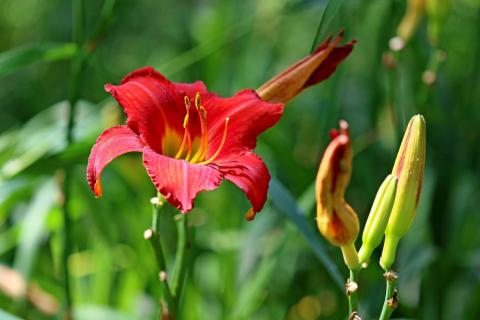August Gardening Tips

Stop fertilizing trees and shrubs with high nitrogen sources by the end of the month.
Fertilizing in late summer can cause some plants to put out new growth that is susceptible to frost damage. The best times to fertilize trees and shrubs are in spring before growth starts, or mid-summer after shoot growth ceases, because root growth and maximum nutrient uptake happen at these times. Additionally, put away the pruning tools for now. Late summer pruning may make plants push new growth that is not winter hardy. Roses are particularly susceptible to damage from late season fertilization and pruning. The ideal time to prune most species is in late winter or early spring while plants are still dormant.
Deadhead perennials to extend the blooming season and encourage plants to direct more energy to their root and shoot systems.
In some special cases, deadheading can even encourage a second bloom later in the season. How to do it properly is determined by a plant’s growth habit and your own preferences. Deadheading perennials isn’t difficult, only time consuming. Although deadheading is specific to each type of plant, all you really need to learn is to cut spent flowers back to a lateral bud or leaf. Only some plants will re-bloom after deadheading, but most will be better for it regardless. Also, from an aesthetic perspective, deadheading perennials gives the garden a cleaner, more polished look. Perennials that typically benefit from deadheading include daylily, iris, hosta, peony, Shasta daisy, coreopsis and dianthus.
Make sure the mower deck is set high, to a height of three inches or more.
Taller grass is more resilient against insect feeding, weed invasion and drought. Mowing high promotes the establishment of a larger and deeper root system, which is more drought tolerant. A larger root mass also makes grass more tolerant of grub feeding, reducing the need for insecticide applications. Taller grass also helps provide broadleaf weed and crabgrass control by shading and cooling the soil surface, equating to less herbicide use.
For the best selection, order garlic bulbs for October planting.
Most companies will wait to ship until close to the proper planting time in your area. Hardneck varieties are hardier than softneck types in New Hampshire and produce flower stalks called scapes. Reliable varieties include: ‘Music’, ‘German Extra Hardy’ and ‘Russian Red’. Garlic grows best in cool temperatures and should be planted in late fall between October and November. Blubs should have just enough time to grow roots before the ground freezes, but not so much that they start to sprout before the winter.
Sow seeds for fall vegetable crops, such as beets, broccoli, kale, carrots, radishes, spinach, collards, lettuce and turnips.
Most fall vegetable crops can be directly sown in the garden or started indoors and transplanted into the garden. Seeding outdoors when the weather is hot can sometimes be problematic because cool season vegetables germinate best at lower temperatures. One way to get around this is to shade and water the soil before you sow. Placing shade cloth over the area you intend to plant is a great way of reducing the temperature and improving germination.
Start weed control in lawns scheduled for renovation.
Most broadleaf weeds and crabgrass can be selectively controlled using a commonly available herbicide. However, it is not safe to seed grass immediately after an herbicide has been used unless otherwise indicated by the product label. Always read and follow label instructions when using herbicides, making sure the product is labelled for the weeds you need to control and observing how long you need to wait before seeding. A broadleaf herbicide will kill weeds that are not grasses. A non-selective herbicide will kill most plants in the area. Consider hand-weeding small lawn areas, focusing on pulling perennial weeds.
Watch for fall webworm on deciduous landscape trees and shrubs, as well as fruit trees.
Fall webworm caterpillars create dirty, loosely woven webs that enclose branches. The caterpillars are very hairy and may be yellow with dark stripes and spots, or a dull blueish black without yellow. Full-grown caterpillars are about an inch and half long. Webworm damage is typically aesthetic issue, not a threat to plant health. Control is not warranted in naturalized areas on wild trees but may be deemed worthwhile on very young trees or valuable landscape plants. Destroying nests by pruning them out or removing them by hand are the most environmentally friendly options.
Do you love learning about stuff like this?
SUBSCRIBE TO GRANITE STATE GARDENING
A monthly newsletter for New Hampshire gardeners, homesteaders and plant-lovers of all kinds, that includes seasonal suggested gardening tips, upcoming events and articles with proven solutions for your garden and landscape.
Got questions? The Ask UNH Extension Infoline offers practical help finding answers for your home, yard, and garden questions. Call toll free at 1-877-398-4769, Monday to Friday, 9 a.m. to 2 p.m., or e-mail us at answers@unh.edu.
